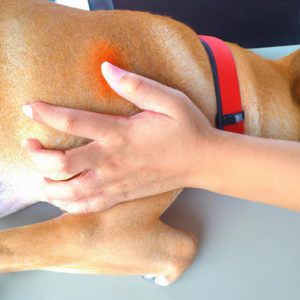Dogs, just like people, can become allergic when exposed to certain food items or other environmental elements.
It may come as a surprise, but skin allergies in dogs are quite prevalent. Fortunately, most of these can be dealt with easily and effectively.
Consulting with a veterinarian is essential if you think your canine is having a skin sensitivity. Taking steps to relieve the allergy and make your pet more comfortable is possible.
Symptoms
Allergies in canines can be triggered by a variety of sources, such as plants, grasses, pollen, dander, insects, food and medication. Signs of these allergies range from intense itching and gnawing to extreme inflammation and skin rashes. Thankfully though, there are strategies to aid our pet in such hard times.
If you suspect your dog has an allergy of the skin, it is important to reach out to a veterinarian for diagnosis. Determining the underlying cause of the allergy can be challenging; however, these tests may assist in finding the source.
Once the root of the problem is determined, allergies in dogs can be handled successfully. These allergies cannot be healed; they must be managed continuously, and it is probable that your dog will need to manage their allergic reactions permanently.
If you find your dog excessively scratching or licking, as well as changes in the fur/skin such as redness or bald spots, it is best to have a vet checkup.
Conditions such as allergies and others may be the source of skin rashes in dogs. To find out which one is responsible for your pet’s skin issues, seek help from a veterinarian. The following are some of them:
A reaction by the skin to a specific allergen leads to an immune response, known as allergic dermatitis.
Canines may suffer from three general types of allergic dermatitis. The most common is Atopy, which is typically triggered by allergens such as trees, grasses and molds that are in the air. A flea allergy can be caused by an adverse response to their saliva. And food allergies occur when a specific protein triggers a negative reaction in the dog after ingestion.
Each type of allergy-induced dermatitis is treated in a unique way. Working together, your vet can help reduce your pup’s exposure to allergens, as well as prescribe treatments that will ease the symptoms.
Fungal infection, known as yeast infection, causes irritation, discharge, and extreme itchiness in different parts of the body.
If your pup is persistently biting their ear or paw, have your vet investigate for a yeast infection. Itchiness and changed skin color are the most frequent symptoms of this infection, which usually establishes itself in paws or ears since they give an ideal situation for yeast to flourish.
Diagnosing yeast infections is a straightforward process and usually necessitates a mix of creams and pills for treatment.
“Staph”, or Staphylococcus aureus, is a bacteria that commonly leads to the contagious skin infection known as impetigo.
In puppies, impetigo is the most common type of bacterial infection. It results in blisters that ooze pus and may form a crust when they rupture, appearing mainly on their hairless abdomen.
In rare cases, impetigo (puppy pyoderma) may spread or persist, though it is generally not serious and can be treated with topical treatment.
An ongoing inflammatory skin disorder, seborrhea is identified by the accumulation of oily scales on the skin.
Seborrhea, resulting in an oily skin with dandruff-like flakes, can be a genetically inherited condition which afflicts a dog from puppyhood and persists throughout its lifetime. On the other hand, it may also be a side effect of an underlying issue such as hormonal imbalance or a skin allergy – in these cases, it is essential to treat the root cause to avoid recurring symptoms.
Ringworm, a common fungal infection of the skin and nails, is something many people experience.
Puppies that are under a year old are particularly vulnerable to ringworm, which is a type of fungus that can cause circular patches of skin inflammation and scaly patches, as well as hair loss. This infection can quickly spread between dogs in a kennel or even to pet owners at home and most commonly appears on the ears and paws.
Parasitic mites are the cause of the skin condition known as mange.
Mange, a skin disorder of the hair follicles caused by mites, can lead to secondary infections and hair loss if left untreated. Sarcoptic mange, also known as canine scabies, is highly contagious and symptoms include itching, redness, and hair loss. Though this may be passed from dogs to humans the mites cannot live on human skin.
In puppies and dogs with compromised immune systems, demodectic mange can cause balding, scabbing, and sores; however, it is not transmittable between animals or humans.
Dry skin is often the result of the skin being lacking in moisture. When this happens, it becomes rough and uncomfortable to the touch.
Flaky skin can be symptomatic of numerous issues such as allergies, mange or other dermal disorders; however, in some cases it is not a cause for worry. As with people, certain canines may have dry skin during wintertime. To ensure your pooch’s wellbeing and healthiness, you ought to provide them with premium nutrition and consult a vet when necessary.
High transmission efficiency of diseases can be seen in hot spots.
Areas on a dog’s hips or chest that are red and inflamed can be identified as hotspots. These areas may be hot to the touch.
Hot spots, caused by a variety of sources such as allergies and compulsive licking/chewing, can be treated effectively by cleaning the affected area and addressing the root cause.

To avoid skin allergies in your dog, preventive measures are always a great idea. Additionally, there are various pet wellness products available that can help with treating specific allergies. If you’re looking to target a certain allergy, you can find products made to do just that.
Some dogs can benefit from coconut oil to maintain skin hydration.
The antimicrobial properties of lauric acid may be beneficial in decreasing the amount of yeast produced by the body. Additionally, capric and caprylic acids have similar properties to lauric acid, as they are known for their antifungal effects.
The inflammatory response can be moderated or suppressed by the anti-inflammatory powers of fish body oil and coconut oil.
Coconut oil may be used both orally and topically on your canine companion. It is important, to begin with, a small amount of the oil to prevent any gastrointestinal or pancreatic issues.
Your pup’s skin can be improved and left feeling silky and healthy with the use of a coconut oil treatment.
 wagwagtail "only love can make your dog wag her tail"
wagwagtail "only love can make your dog wag her tail"
